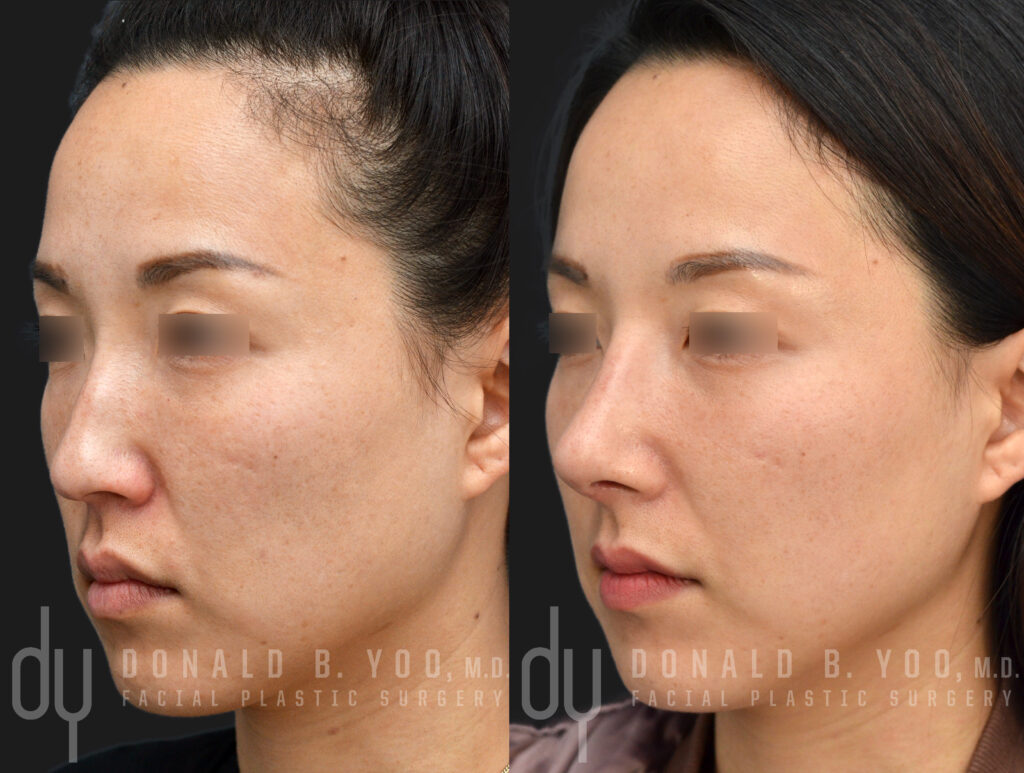The bridge of the nose, or the nasal dorsum, represents a subtle yet visually impactful component of the nose and of the face as a whole. The width, height and shape of the dorsum has an effect on the appearance of the balance of the face and especially in terms of the projection of the mid-face and cheeks, the appearance of the eyes and the area between them, and the side profile and oblique facial proportions. In Asian nose job surgery the dorsum of the nose is often low or wide, or a combination of both. Bone comprises the upper third of the bridge, while there exists an important “keystone” area where the bone interfaces with cartilage along the middle-third of the bridge. Critically, any surgical approach to augment the dorsum must preserve this connection, but also become integrated with it so as to provide a bridge that is solid and does not move, just as the original bone and cartilage do not. Any material that is placed on top of the natural bone and cartilage, but does not integrate with it, will be predisposed to migration and eventually extrusion through the skin.
The best material then, for creating a permanent change to the shape of the nose is material that will integrate and become 100-percent a part of your nose, and the only material that will do this is tissue from your own body. For this reason, the best Asian rhinoplasty surgeons have spurned the use of synthetic materials such as silicone, Goretex and Medpor in favor of cartilage from the ears or from the ribs. Depending on the amount of augmentation, and the concomitant changes to the shape of the nose with respect to the tip and ala desired, ear cartilage or costal cartilage may offer the superior option. For the greatest degree of tip-refinement and augmentation, rib cartilage offers the benefit of a plentiful volume of strong, straight cartilage to provide structural grafting.

When using rib or costal cartilage in Asian nose job surgery, rhinoplasty surgeons may opt to carve a single piece of rib cartilage (en bloc rib cartilage) use diced cartilage which is glued together (diced cartilage glue or DCG) or dice the cartilage it and use fascia as a wrapping to create the desired shape (diced cartilage fascia or DCF). En bloc rib cartilage has the risk of warping and migration, as it is difficult for the solid block of cartilage to precisely adhere to the underlying bone and cartilage of a natural bridge. Contour irregularities are also not uncommon given the challenge of carving a solid piece of cartilage to mimic the smooth contours of a natural nose bridge. DCG eliminates the risk of warping, as the cartilage is diced. It also has a higher chance of incorporating with the underlying nasal dorsum, as the diced cartilage can easily accomodate the shape of the underlying nasal framework. However, given the tissue glue used in between pieces of diced cartilage, cobble-stone contour irregularities may result, and given the un-contained nature of the diced cartilage, the surgeon has less control with regards to where the cartilage ultimately resides along the dorsum. The DCF technique is also not without downside, as it is the most technically demanding to create a precise result, and also requires the most time in surgery to perform, as well has results in the longest recovery time to the patient. Fascia provides an exact shape for the diced cartilage to congeal and solidify into, while allowing the diced cartilage to become tightly packed to itself without the need for any tissue adhesives in between the pieces of cartilage. When performed masterfully, a nasal dorsum constructed from diced cartilage fascia will look and feel exactly like a natural nose bridge.
Learn more: https://www.donyoomd.com/services-asian-rhinoplasty.php
 Contact Us
Contact Us